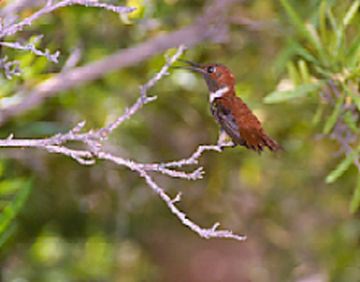|
1. I've always heard that you should take your feeder down by Labor Day. I forgot and left mine up and now it's December and I just noticed there's a hummingbird at the feeder. Since it has already missed migration, I want to catch it and bring it inside so it won't die from the cold. Should I? I live in Pennsylvania.
- It is illegal for anyone without a state and federal permit to trap and hold in captivity any species of wild migratory bird, including hummingbirds. The laws are strictly enforced and can result in stiff fines and/or imprisonment, so don't try to catch the hummingbird.
- The first thing you should do is clean your feeder, make a fresh mixture of sugar water, and hang the feeder back up so that your bird can eat artificial nectar that isn't all moldy.
 You may need to bring the feeder in each evening at dusk so that it doesn't freeze up. Then put it back out in the morning. If the temperatures are very cold, you might want to have two feeders, so that you can put a warm one out at mid-day and bring the other one in to warm back up. (Some people devise elaborate sun lamps and heat tape to keep their feeder from freezing.) You may need to bring the feeder in each evening at dusk so that it doesn't freeze up. Then put it back out in the morning. If the temperatures are very cold, you might want to have two feeders, so that you can put a warm one out at mid-day and bring the other one in to warm back up. (Some people devise elaborate sun lamps and heat tape to keep their feeder from freezing.)
- The bird at your feeder in December is probably NOT a Ruby- throated Hummingbird (Archilochus colubris), the species that breeds in Pennsylvania and normally departs for the tropics before mid-October each year. It's more likely that you have one of the winter vagrant hummingbird species that normally breeds in the western U.S. or Canada.
- The most common winter vagrant in the eastern U.S. is probably the Rufous Hummingbird (Selasphorus rufus), which breeds primarily in Oregon, Washington State, and British Columbia and normally overwinters in central Mexico. Rufous Hummingbirds (above) are being seen in the eastern U.S. with increasing frequency, but ten or more western or Mexican hummingbird species have been known to appear in the eastern U.S. in fall and winter.
- Rufous Hummingbirds in particular seem to be able to survive cold temperatures, perhaps because they go into torpor at night and lower their body temperatures by 30 degrees F.
- If your winter hummingbird got to your northerly latitude in Pennsylvania on its own, you ought not hold it for the winter in some warm, indoor aviary and then release it the next spring. That could just encourage it to return the following winter and--if wayward migration is genetically determined--might result in its offspring making the same trip and tempting you to bring them indoors also. If this happened, in a few generations Pennsylvania could be overrun with Rufous Hummingbirds standing in line for winter housing, and that's not in anybody's--or any bird's--best interest. We'd be a lot better off letting natural selection determine the lot of winter vagrant hummingbirds. If they make it through the winter on their own, fine; if they don't, it should be just as acceptable. This may sound dispassionate, but that's the way nature works.
- Lastly, be sure to report your winter hummingbird immediately to RESEARCH. (You can also contact a local bander directy at Hummingbird Banders.) When we get information about a winter hummingbird, we can pass the details to a hummingbird bander near you who may be able to come to trap and band the bird, confirm its species, and then release the bird unharmed. If this bird is then found or recaptured at another location, the band will provide much-needed information about the behavior of these winter vagrant hummingbirds. (See Vagrant & Winter Hummingbird Banding.)
|

